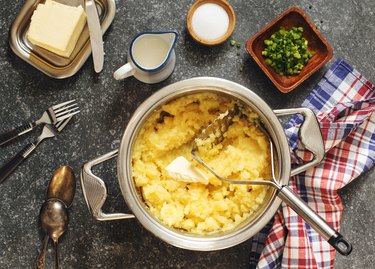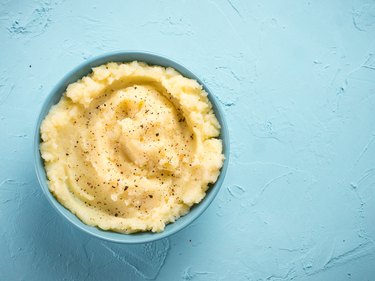
Some of the most popular side dishes are the simplest. A perfect example? Deliciously creamy mashed potatoes with melted butter are solid-gold comfort food. They require minimal prep time, and making them from scratch is a breeze. That said, knowing how to make mashed potatoes is one thing, but knowing how to make the best mashed potatoes is another story. To get you started, we've compiled a few expert chef tips and tricks to help you step up your mashed potato game and avoid common cooking mistakes, whether you're perfecting a beloved homemade recipe for a holiday gathering or whipping up a batch just because.
Ready for the delectable details? It's time to peruse our mashed potato FAQs!
Video of the Day
Video of the Day
1. Which potatoes are best for mashing?
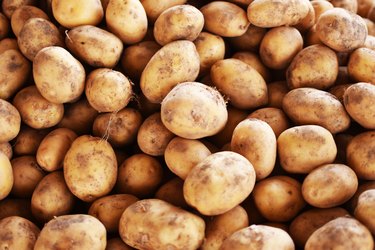
Russets are the best potatoes for mashing. They cook up with a dry texture to make fluffy mashed potatoes, perfect for soaking up gravy, butter or any topping you choose. Waxy potatoes (such as fingerlings or many red potatoes) are better used in soups, stews or potato salads, where their sturdiness when boiled is an asset.
That being said, French cuisine favors a slightly waxier potato for pommes purées. The preferred option is a fingerling potato called la ratte (it means exactly what you think it does; if you squint at a fingerling, it's kind of rat-shaped!). But Yukon Gold potatoes are an easier-to-find alternative if you want to try the rich, buttery French-style mash.
2. How should I cook potatoes for mashing?
No potato is perfect—and russet potatoes' shortcoming is that they tend to get mushy when boiled. To prepare them for mashing, here are a few tips to keep in mind:
Start cold: Begin by placing potatoes in a large pot of cold water (not boiling water), so their outsides won't be cooked (and falling apart) before the middles are done.
Cut into large pieces: Create generously sized pieces, ideally chunks no smaller than 1 1/2 in. to 2 in. Small to medium potatoes can even be boiled whole in their skins, though skinning hot potatoes afterward can be tricky.
Generously salt water: Salt cooking water before you boil potatoes. This is a win-win, as completed potatoes will taste better and you won't need to add as much salt to the finished dish.
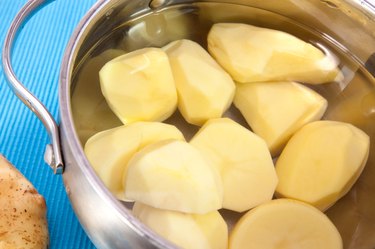
Opt for a low boil: Don't cook at a rolling boil, which will tend to make russets mushy on the outside. Instead cook at a low boil, or even just below the boil at a simmer, which will result in more even cooking. You can also prep them in a slow cooker, which takes longer but can be convenient during the holidays when your kitchen stove is busy.
Check for tenderness: Cook potatoes until they're tender in the middle when tested with a toothpick or the tip of a paring knife. (A fork will tend to make them break up, so think of "fork tender" as a metaphor rather than an actual suggestion.)
Let potatoes chill: After you drain potatoes, turn off the stove burner, return potatoes to the pot and let them sit on the now-cooling burner for a few moments, shaking periodically, until the cloud of steam slows down. This helps remove excess moisture from boiling so potatoes will be drier and ready to accept any add-ins.
3. What kind of masher should I use for my mashed potatoes?
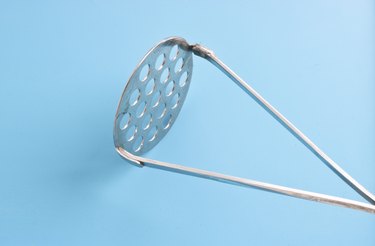
In the past, the oldest and simplest potato masher was just a thick, rounded stick, like a small baseball bat. Those are inefficient, though, so most of us now use a masher with either a grid-shaped pattern, a zigzag pattern or parallel bars to do the mashing. The one you choose will largely come down to personal preference. (And don't overlook the importance of a comfortable handle!)
With conventional mashers, you'll typically have an uneven texture with occasional lumps of un-mashed potato. If you're shooting for a smoother, restaurant-style result, you may find you get better results by passing cooked spuds through a potato ricer or a food mill instead. A ricer squeezes potatoes through a metal cup with small perforations, which turns the potatoes into fine strands resembling rice or vermicelli noodles. A food mill uses a rotary handle to press the potatoes through a metal disk, which has a similar effect. Some cooks will also use an electric mixer or food processor to mash their potatoes, though that can potentially leave your potatoes unpleasantly gummy or gluey.
4. Why are my mashed potatoes gluey?
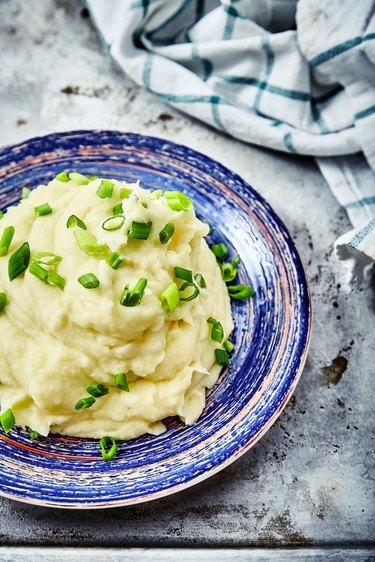
If you've got gluey mashed potatoes, the culprit is the very starch that makes potatoes light and fluffy. If you overwork potatoes—much easier to do with a mixer or food processor, but entirely possible with hand-mashing as well—you'll break down starch molecules. That releases excess starches, which basically turn into paste, just as your gravy will if you add too much thickener (which, again, is starch). It's worth noting that trying to get those last few lumps out of your mashed potatoes is one way you might get into this predicament, which is an argument for buying a ricer or a food mill. They'll give you a perfectly smooth result without the risk of overworking your spuds.
You can't really rescue potatoes once they reach this stage (though you can find ways to repurpose them, so they aren't necessarily wasted). You're better off starting over with a fresh pot of potatoes or falling back on instant mashed.
5. Do I have to add milk to my mashed potatoes?
Almost any mashed potato recipe will call for milk, half-and-half, heavy cream, butter or even richer options such as sour cream or cream cheese. Are they necessary? Absolutely not. For a weeknight meal, you can just mash your potatoes as is, hit them with a sprinkle of salt and black pepper, and call it good. But that doesn't mean you shouldn't add in any extras. Milk makes your potatoes moister and slightly richer, without taking away from their light and fluffy texture. Buttermilk does the same but adds a faintly cheesy tang that works well with many meals.
Tip
Make sure add-ins like milk and cream are well-warmed before you add them to potatoes. Otherwise they’ll cool potatoes down and not mix in well.
6. Which add-ins are best for mashed potatoes?
Add-ins really depend on the situation. If your mashed potatoes are going to be served as part of a large meal, it's probably best to keep the potatoes fairly simple and low-key. Aside from salt, pepper, whole milk and maybe butter, consider limiting yourself to a garnish of chopped parsley, green onions or chives for their fresh color. If you want to switch things up just a little bit, other chopped fresh herbs such as rosemary, dill or fenugreek leaves (kasoori methi at your local Indian food store) are tasty alternatives.
If the rest of the meal will be relatively simple, let your imagination run wild. Softened cream cheese, grated hard cheeses, roasted garlic, Parmesan, diced ham, crumbled crisp bacon, sausage crumbles or their respective vegetarian alternatives are all fine add-in options that will make your potatoes rich and wonderful. Truthfully, with add-ins like these, you don't even really need a separate protein item to have a complete meal. Think of these "loaded" mashed potatoes as the equivalent of a baked potato, minus the skin!
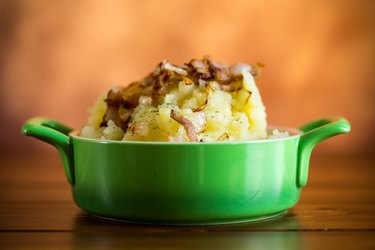
7. Can I freeze leftover mashed potatoes?
Yes, though results are inconsistent if you freeze mashed potatoes on a whim. Simple mashed potatoes with few add-ins will often have an inconsistent or watery texture when reheated, which isn't exactly what you're looking for. This is a case where richer mashed potatoes, with generous quantities of butter, cream or cream cheese, work better. The extra fat surrounds starch molecules and protects from the freezing and thawing process.
Freeze mashed potatoes either in a single meal-size dish or individual portions. For a single dish, choose something in ceramic or glass that can go from oven to freezer and vice versa. Smooth potatoes as flat as you can get them, then press a piece of parchment paper directly to the surface of the spuds to protect them from contact with air. Slide entire dish into a freezer bag and squeeze out as much air as possible. For individual portions, scoop onto a parchment-lined sheet and freeze them for 2 to 4 hours, then bag now-hardened portions in a freezer bag with as much air as possible removed. (A vacuum-sealed bag is best, if you have a sealer.)
Either way, reheat your potatoes at low heat in an oven (for single portions, you can also use a microwave), then taste them and fold in additional seasonings, butter or dairy until you reach the desired consistency and flavor.
8. What are the best recipes for leftover mashed potatoes?
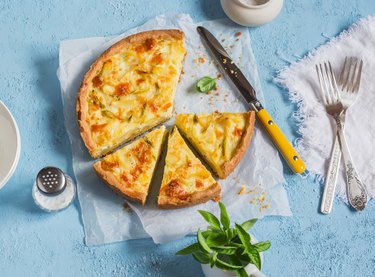
There are so many ways to use leftover mashed potatoes that you might actually consider making extra every time you whip up a batch! Here are a few of our faves:
Potato patties: Mix a beaten egg into your leftover mashed as a binder (you may not need it if the potatoes contain cheese or cream cheese), then shape into patties and fry them crispy and brown as an accompaniment to breakfast or any other meal.
Croquettes: Shape an egg-and-potato mixture around a filling of cheese, sausage or leftover salmon—almost anything, really—then bread these croquettes and fry or bake them until golden.
Potato soup: Make a quick potato soup by thinning leftover spuds with broth or milk.
Meat pies: Leftover mashed potatoes are the standard topping for shepherd's pie, but you can also use them on a fish-based stew (fisherman's pie) or as both the top and bottom crust on a meat pie.
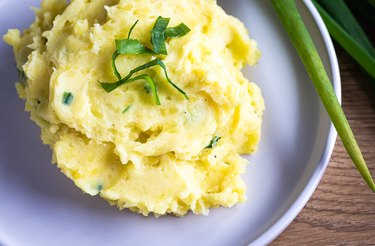
No matter which way you mash it, the truth is clear: Better mashed potatoes are in your future! Whether you're feeding an entire family for the holidays or mashing spuds for a solo starchy meal, we hope our expert tips lead to fluffy, buttery deliciousness galore.
